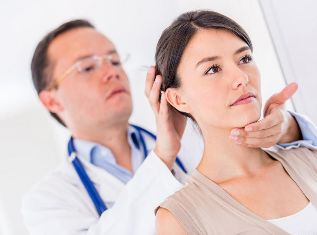Like other spinal diseases, grade 1 cervical osteochondrosis is characterized by pain. The nature of the pain can be called tolerable, but it does not cause the disease to leave without medical attention and further treatment. Ignoring the symptoms of osteochondrosis, which is still in stage 1, can aggravate the patient's condition and lead to further development of the disease.
Self-medication is not recommended, only an experienced doctor can make a correct diagnosis, determine the cause of the symptoms of the disease and give accurate recommendations on how to deal with osteochondrosis.
Causes of the disease
Against the background of first-degree osteochondrosis of the cervical spine, there is primarily a shooting pain called lumbago. The pain syndrome spreads to the cervical region, and in severe cases to the shoulders, arms and chest muscles. This is due to the fact that the intervertebral discs are more prone to damage where the moving part of the spine (cervical region) is less mobile and is connected to the thoracic region.

The cervical region consists of 7 vertebrae. The first two support the skull, so a person can turn, bend and lift his head. The vertebrae are connected by joints and mobile ligaments, and the intervertebral discs, made up of cartilage tissue, create a space between the vertebrae. The adjacent muscles are also designed to keep the spine upright, and if the muscle corset is well developed, the spine is stable. As you can see, well-coordinated work of the vertebrae, intervertebral discs and muscles ensures the healthy functioning of the spine. As soon as a connection from this system begins to break down, disturbances occur in the entire work of the spine.
What are the possible causes of disorders and the first symptoms of osteochondrosis appear:
- sedentary lifestyle;
- excessive physical activity;
- wrong position during sleep;
- nutrition that does not provide the body with enough nutrients to strengthen the bone and muscular system;
- bad habits;
- stress;
- lack of rest, fatigue;
- often hypothermia and colds.
The muscles that support the spine in a stable position begin to age and lose tone by the age of 50 - this can be considered normal. However, when the cervical vertebra undergoes a deformation process at the age of 20, it is worth paying attention and moving. Get preventive treatment, exercise, be active, and avoid sedentary work with your neck and back bent.
symptoms
The concept itself needs to be clarified in order to list the main signs and symptoms that can accurately diagnose grade 1 cervical osteochondrosis.
Grade 1 osteochondrosis is the earliest stage of the disease, so far it is characterized only by compression of the cartilage tissue of the discs between the vertebrae. The vertebral column is still in a stable position, but the fork-shaped processes of the spine are already increasing in size. The displacement of the disc is minimal, but the outer sheath of fibrous tissue begins to separate, which, if left untreated, can lead to the development of subsequent osteochondrosis and even intervertebral hernia.
The main symptoms of cervical spine osteochondrosis:
- pain syndrome begins in the neck and spreads to the shoulder joints, shoulder blades and chest muscles;
- Compression of the nerve endings causes shooting pain in the neck, especially aggravated by an uncomfortable posture during sleep, after waking up at night, the patient holds his neck in an unnatural position due to the inability to turn his head painlessly;
- Heart syndrome can occur against the background of nerve root compression - pain in the chest muscles, which is confused with heart pain in a person (examination does not confirm the presence of heart pathology);
- Due to the vertebral artery syndrome, the blood supply to the brain and spinal cord deteriorates, which causes headaches, visual disturbances in the form of "flying in the eye", dizziness, pain in the occipital region;
- sleep disorders;
- worry.

Pain syndrome is accompanied by muscle spasms in the affected lumbar region. Grade 1 osteochondrosis of the spine cannot provide the listed symptoms, it all depends on the body's pain and the patient's general well-being.
Any of the symptoms of the disease are more acute with constant fatigue, sedentary work and stress. Therefore, the first sign of osteochondrosis - especially shooting pain in the neck after physical exertion or hypothermia - should be a reason to see a doctor.
Treatment and prevention
Treatment of grade 1 cervical osteochondrosis should focus primarily on the elimination of the pain syndrome and the initiation of active metabolic processes in the tissue of the intervertebral discs. It is also important to strengthen the skeletal muscle so that the spine remains stable and strong.
Drug treatment includes the following methods:
- painkillers, anti-inflammatory drugs;
- physiotherapy;
- massage;
- acupuncture;
- medical gymnastics;
- swimming.
Pain and inflammation in the affected area should be relieved with medication, in which case the doctor may combine the appointment of oral anesthetics with vitamins, anti-inflammatory drugs. Good effect is given by the application of foreign substances in the form of warming gels based on painkillers, in addition to bee and snake venom.
In addition to medication and physiotherapy, there may be additional therapeutic exercises that will help to gently stretch the spine, loosen the compressed nerve roots, and relieve neck pain. The next preventive measures are a healthy, active lifestyle, exercise, good nutrition, but also to avoid stress and hypothermia.























